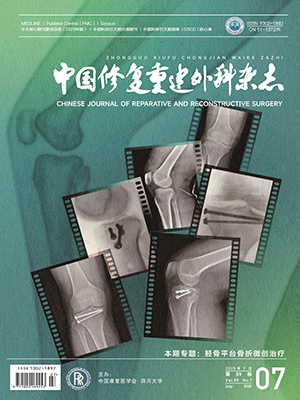| 1. |
Salvi AE. Lisfranc Injuries:a matter of ligament disruption. J Foot Ankle Surg, 2014, 53(5):674-676.
|
| 2. |
Saab M. Lisfranc fracture-dislocation:an easily overlooked injury in the emergency department. Eur J Emerg Med, 2005, 12(3):143-146.
|
| 3. |
Sands AK, Grose A. Lisfranc injuries. Injury, 2004, 35 Suppl 2:SB71-76.
|
| 4. |
DeOrio M, Erickson M, Usuelli FG, et al. Lisfranc injuries in sport. Foot Ankle Clin, 2009, 14(2):169-186.
|
| 5. |
Peicha G, Labovitz J, Seibert FJ, et al. The anatomy of the joint as a risk factor for Lisfranc dislocation and fracture-dislocation. An anatomical and radiological case control study. J Bone Joint Surg (Br), 2002, 84(7):981-985.
|
| 6. |
侯彦杰,闫斌,韩亚军,等.金属植入物内固定修复跖跗关节损伤:18例生物力学评价.中国组织工程研究, 2014, 18(35):5693-5698.
|
| 7. |
Welck MJ, Zinchenko R, Rudge B. Lisfranc injuries. Injury, 2015, 46(4):536-541.
|
| 8. |
Marsland D, Belkoff SM, Solan MC. Biomechanical analysis of endobutton versus screw fixation after Lisfranc ligament complex sectioning. Foot Ankle Surg, 2013, 19(4):267-272.
|
| 9. |
田竞,周大鹏,于海龙,等.双Endobutton治疗单纯Lisfranc韧带损伤.中华创伤骨科杂志, 2012, 14(9):752-754.
|
| 10. |
Nery C, Ressio C, Alloza JF. Subtle Lisfranc joint ligament lesions:surgical neoligamentplasty technique. Foot Ankle Clin, 2012, 17(3):407-416.
|
| 11. |
Hirano T, Niki H, Beppu M. Newly developed anatomical and functional ligament reconstruction for the Lisfranc joint fracture dislocations:a case report. Foot Ankle Surg, 2014, 20(3):221-223.
|
| 12. |
Miyamoto W, Takao M, Innami K, et al. Ligament reconstruction with single bone tunnel technique for chronic symptomatic subtle injury of the Lisfranc joint in athletes. Arch Orthop Trauma Surg, 2015, 135(8):1063-1070.
|
| 13. |
Nunley JA, Vertullo CJ. Classification, investigation, and management of midfoot sprains:Lisfranc injuries in the athlete. Am J Sports Med, 2002, 30(6):871-878.
|
| 14. |
Libby B, Ersoy H, Pomeranz SJ. Imaging of the Lisfranc injury. J Surg Orthop Adv, 2015, 24(1):79-82.
|
| 15. |
文艺,冯品,张晖,等.同种异体肌腱与螺钉固定修复Lisfranc关节韧带损伤的生物力学比较研究.四川大学学报:医学版, 2013, 44(2):222-225, 241.
|
| 16. |
Solan MC, Moorman CT 3rd, Miyamoto RG, et al. Ligamentous restraints of the second tarsometatarsal joint:a biomechanical evaluation. Foot Ankle Int, 2001, 22(8):637-641.
|
| 17. |
徐虎,张春礼,李明全.关节镜下前交叉韧带移植重建术后骨道扩大的研究进展.中国微创外科杂志, 2005, 5(5):395-396.
|
| 18. |
李智尧,张磊,刘劲松,等.关节镜下胫骨端RigidFix、股骨端IntraFix固定技术重建后交叉韧带.中国微创外科杂志, 2014, 14(1):7-11.
|
| 19. |
Weglein DG, Andersen CR, Morris RP, et al. Allograft reconstruction of the Lisfranc ligament. Foot Ankle Spec, 2015, 8(4):292-296.
|
| 20. |
Johnson A, Hill K, Ward J, et al. Anatomy of the lisfranc ligament. Foot Ankel Spec, 2008, 1(1):19-23.
|
| 21. |
李春光,俞光荣,李兵,等.内侧楔骨与第2跖骨底间韧带的解剖研究及临床意义.中国临床解剖学杂志, 2012, 30(2):119-122.
|




